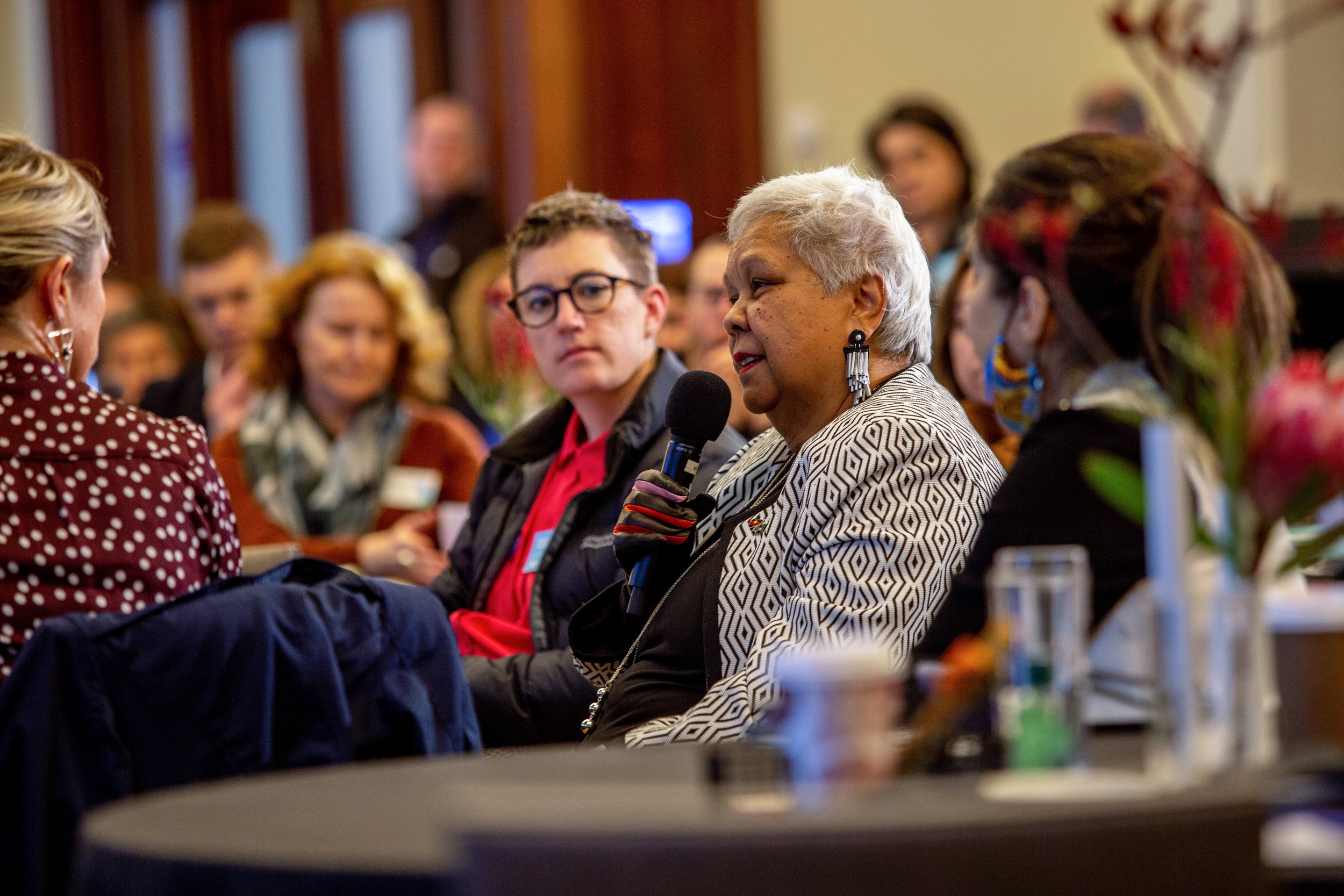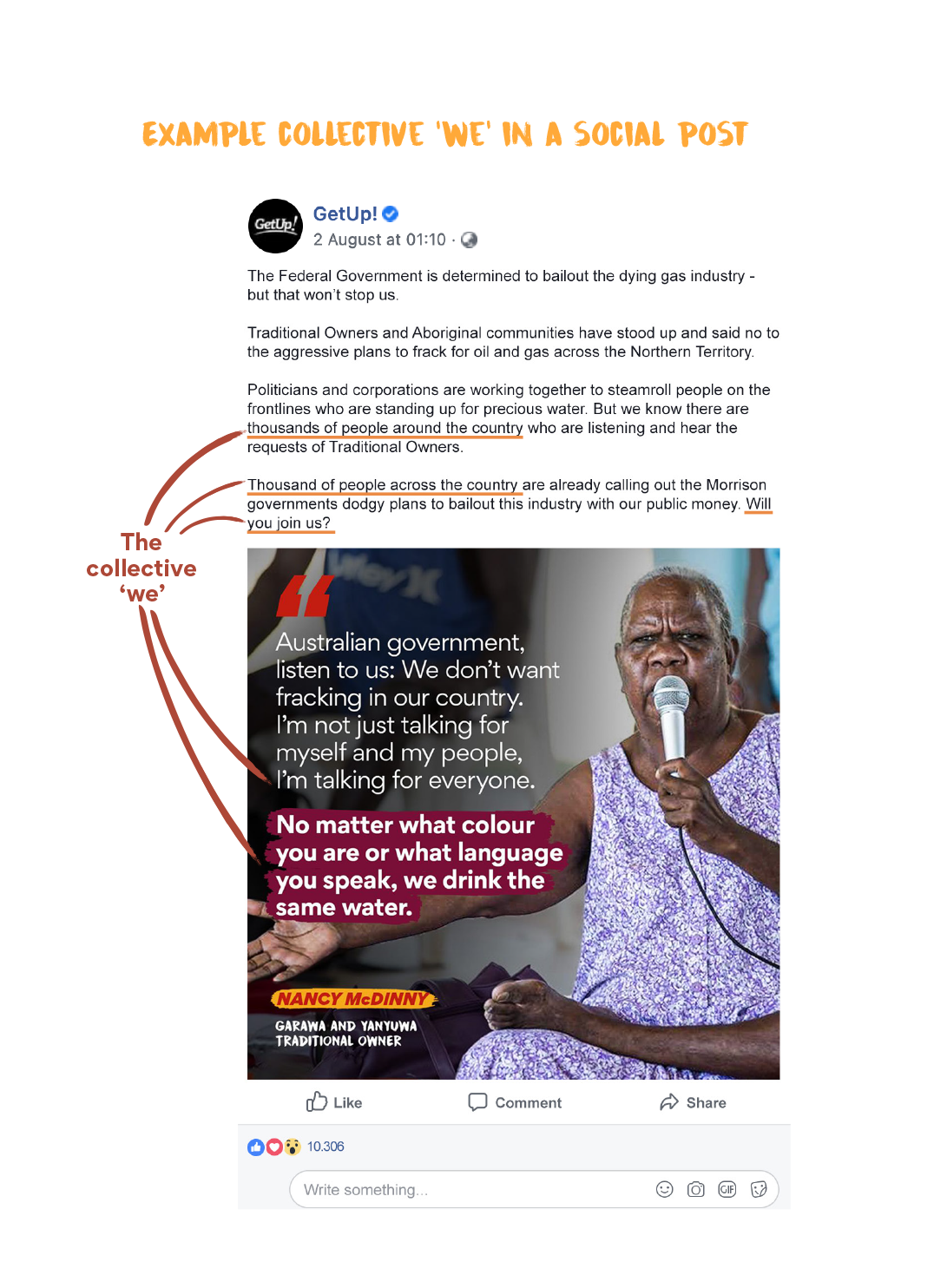
winning support for self-determination and justice
Our foundational research tells us…
We can build widespread support for self-determination and justice when we lead with our strength and solutions.
These recommendations can be applied to any issue you’re working on, from protecting Country, to stopping Black deaths in custody, health equity, housing and more.
Lessons from the foundational research
Apply our seven messaging recommendations
Scroll down to see the recommendations
Show me how to use metaphors in my writing
Scroll down to learn the magic of metaphors
Embrace messages proven to shift persuadables
Scroll down to see how we can persuade the persuadables

“I hope this project gives you the confidence to speak our truth and share our strength. Together, we can defeat the entrenched deficit narratives, and work towards a better future for everyone.”
Dr Jackie Huggins AM
seven messaging tips
To build widespread public support for self-determination and justice
1.
Start messages with a shared value
Powerful values like equity, taking care of one another, freedom, and knowing what’s best for ourselves can build support for self-determination and justice. By crafting messages around a shared value, we can bring our audiences along, and show how the barriers we face violate widely-held values.
Here are some message examples that include a universal shared value:
-
Respect
Everyone should be treated with respect, regardless of their skin colour, gender or postcode. But today, our federal government is segregating and targeting our communities. Their policies control where we can go, what we can do and what we buy.
-
Family
Every person wants to be able to go to their family when they need help. But today the federal government chooses where we can go and who we can see. They control which shops we can spend our money at, stopping us from being able to travel to see family.
-
We know best for us
We are better off when we are free to make the choices that are best for us. But today, the federal government decides who does and doesn’t get to choose the food they buy or the shops we can visit, based on the colour of our skin.
-
Freedom
Everyone wants the freedom to choose where they spend their money. But today, the federal government targets our communities, and controls where we can shop and what we can buy, based on the colour of our skin.
2.
It’s time to reclaim our strength
We need to share many stories of our strength and leadership. This helps people to believe we’re capable of making good decisions and support our demands for self-determination.
Embrace
“We are strong and capable.”
“We need your solidarity.”
“We make our own decisions about what’s best for our people and for country - we’ve got this.”
“We are strong despite current injustices.”
“65,000 years of wisdom and leadership.”
Replace
“We are vulnerable, we are broken.”
“We need your help.”
“Aboriginal people are vulnerable and need the government to step in and help them.”
“The current situation for a lot of Aboriginal people and their communities feels hopeless.”
3.
Name the unfair barrier we face, who is causing us harm and why
We need to shine a light on who causes the problems we face, and why. This helps the audience to understand who is responsible for the problem, and understand it can be fixed.
Here’s how to bring the ‘who’ and ‘why’ into your messages:
-
Who is causing the harm
We want to make clear that people made the problems we face. Sometimes, it’s really hard to narrow down who is responsible to a single person. That’s because we’re feeling the impacts of centuries of colonisation, unfair policies and racism.
By naming a specific person, minister, or even ‘X government', we help our audience to understand that people are making active choices to harm us.
Ask questions like: Who caused this problem? Who made this decision? Where did this problem start? Who keeps this barrier in place? The more specific we are, the clearer our problem and solution are.
-
Why - name the credible motive
People are much more likely to believe that people are causing us harm, when we describe why.
Ignorance was the most credible motive we tested, and helps to position us as the experts we are. You could use it by including statements like “X government doesn’t understand what’s best for us”.
We found racism and discrimination are equally credible motives. You could include statements like “X Minister’s racist policies”, “X are targeting us based on the colour of our skin”.
Profit is another credible motive. You could include statements like “X Minister has cut funding to housing, so mining corporations can come in and profit off our land”.
4.
Combine truth and action
Our messages need to include the current injustices we face. This truth telling is important because it helps our audience resonate with the content. When we combine current injustices with clear asks and solutions, we gain the support of both our community and persuadables.
An important note - without a clear ask or solution, persuadables can get stuck in feelings of guilt and defensiveness when they hear our truths, which makes it hard to gain their support.
Start by…
Naming the current injustices we face, or connecting historic injustice to modern impacts.
Then back this up with…
A clear ask or action that our audiences can do. The research shows clear, simple, bold asks are effective.
5.
Create a collective ‘we’
Our base and persuadables are nervous that self-determination means segregation. We can overcome this by bringing them into the message and including clear asks for their solidarity.
Here are three ways to write a collective ‘we’
1.
Use values to create a universal we: “Just like parents everywhere, we want what’s best for our kids”.
2.
Ask for solidarity: “We all have a responsibility to…”, “Hear our stories and…”, “Stand with us…”
3.
Use groups of three: “Whether your family’s been here 5 years, 5 generations or 5000 generations…”
Here’s an example of how GetUp’s First Nations Justice team used collective ‘we’ in a social media post.
6.
Explain big concepts in simple language
Many people don’t understand concepts like self-determination, systemic racism, colonisation and equity. We need to put these terms in plain language and use metaphors to convey our message. When we do, we get wide support.
Self-determination is a big idea, with a big vision. Help make it tangible with examples, such as: “Aboriginal people should have the final say on what does and doesn’t happen on their land.”
Simple language for self-determination
“First Nations people in charge.”
“In the driver’s seat.”
“We make the decisions that affect our communities.”
“Community control.”
“We want a better, fairer society led by our values of caring for everyone.”
Simple language for systemic racism
“X person targeting us based on the colour of our skin.”
“Unfair policies that divide us based on who we are and where we live.”
“Racist policies that unfairly target people based on the colour of their skin.”
7.
Never negate: don’t repeat the opponent message
When need to tell our own story, and we need to repeat it over and over.
Whenever we try to myth bust, or say the opponent’s message is untrue, we’re helping them by repeating (and reinforcing) their message.
Embrace
Say what we are and always speak from our frame.
Our own powerful messages that the opponents feel like they need to myth bust and negate, such as: “we are strong and capable people, and know what’s best for our families, communities and country”.
Replace
Avoid phrases like “we are not” - otherwise we risk repeating the opposition message.
Stay away from language like “we don’t get special treatment” - otherwise people remember ‘us’ and ‘special treatment’.
Language in the Uluru Statement like “...we are the most incarcerated people on the planet. We are not an innately criminal people...” connects our people with the concept of being ‘innately criminal’.


A note on metaphors
Metaphors are incredibly powerful at shaping how people understand complex ideas like self-determination. We need to embrace helpful metaphors, and steer clear of those that invoke the deficit frame or negative ideas about us.
Embrace
Free
“People are better off when they are free to set their own course”, “when we are free to be who we are”.
Journey
“In the driver’s seat”, “move forward together”, “walk with us”, “to a better future”, “chart our own course”.
Build
“Work together to build a better future for everyone.”
replace
Black / dark
When used to mean “bad”, as in “our dark past”, “a black day for this country”.
Gap
“Close the gap.”
Reconcilliation
Which means to make up after a fight, but we were never friends to begin with.

embrace messages proven to shift persuadables
Here are the messages we ‘dial tested’ to find words and phrases most likely to build support of the persuadable audience.
Advocate message #1: Equal treatment
‘Equal treatment’ was one of our most effective messages, because it taps into a universal value of equity.
Everyone deserves to be treated with equal respect and dignity.
But today, the Federal Government enacts a racist system that unfairly targets people based on their colour and blocks them from setting their own course. We have aggressive policing of Aboriginal children, controls put on what Aboriginal people can spend their pensions on, and discrimination when applying for jobs.
We need to work together, whether we've been here for 5 years, 5 generations or 5000 generations, to redesign things so it’s fair for everyone.
With a system that reflects the values we all share, everyone, no matter who they are, can be treated equally.
Here’s a video that shows how persuadables respond to the ‘equal treatment’ message:
First Nations people (purple), base (green), persuadables (yellow), opposition (red)
Advocate message #2: Community knows best
‘Community knows best’ is a strong message we can use to highlight the ignorance of governments, and show that we have the capability and knowledge to lead solutions for our community.
People are better off when they are free to set their own course.
Yet the government keeps locking us out of decisions and forcing their policies on us, insisting they know what’s best for Aboriginal people.
But we know what our communities need. 40 years ago, when government health services were failing us badly, we took the driver's seat and set up Australia’s first community health centres. Today, our services are the best in the country and the government models their health, legal aid and childcare systems on ours.
Our people are strong and resilient and when we are free to choose our own path, the whole country benefits.
Here’s a video that shows how persuadables respond to the ‘community knows best’ message:
First Nations people (purple), base (green), persuadables (yellow), opposition (red)
Advocate message #3: Making our own decisions
This message is quite simple - self-determination is ‘making our own decisions’.
When people are free to make our own decisions and live our lives the way we want to, we thrive.
But today, the Australian Government forces its own ideas on how we, as Aboriginal people, should lead our own lives. Decisions about our health, our education and our homelands keep being taken away from us.
It’s time to restore our right to make decisions for ourselves, our families, our communities and our homelands.
Our people and our culture are strong and resilient and, just like everyone else, we thrive when we can set our own course.
Here’s a video that shows how persuadables respond to the ‘making our own decisions’ message:
First Nations people (purple), base (green), persuadables (yellow), opposition (red)
Status quo message: Deficit
We tested our messages against the deficit, status-quo message. This is a very persuasive message - why - because people have heard it so many times.
The more people hear a message, the more they believe it. But the good news is, people are extremely receptive to strength-based messages, and we can defeat the deficit message by using the recommendations above.
Taking care of one another is what community is all about.
But the government isn’t taking care of us. Since colonisation, Aboriginal people have been trapped in a vicious cycle of poverty and disadvantage, unable to improve the wellbeing of our communities. Our health outcomes are poorer, our suicide rates higher, and drug and alcohol use affects too many families.
We need the government to help us get back on our feet by putting us in the driver’s seat.
When we steer the policies and programs that impact our communities, we can make sure everyone in our community is taken care of.
Here’s a video that shows how persuadables respond to the ‘status quo deficit’ message:
First Nations people (purple), base (green), persuadables (yellow), opposition (red)
Opposition message: using ‘fair’ as special treatment
Our opponents also use the ‘equal or fair’ frame, but they describe it as treating everyone the same and getting rid of ‘special treatment’ for Aboriginal people.
Their messages are very persuasive, so make sure you don’t repeat them, negate them or myth bust them - as that will just reinforce their story.
Every Australian deserves a fair go.
But our government continues to set double standards by giving Aboriginal people special treatment. While it’s true that a lot of bad things happened in the past, today Aboriginal people have an easier ride than most because of all the handouts, scholarships and jobs the government provides.
Making Aboriginal people dependent on government support doesn't help them in the long run and it’s not fair on everyone else - treating people differently creates conflict and division.
By removing these double standards we can make sure that every Australian has the same opportunity.
Here’s a video that shows how persuadables respond to the ‘opposition’ message:
First Nations people (purple), base (green), persuadables (yellow), opposition (red)











